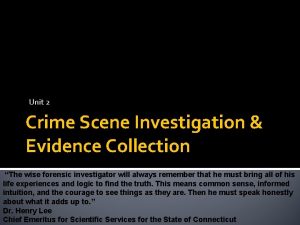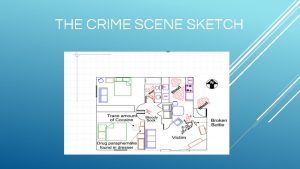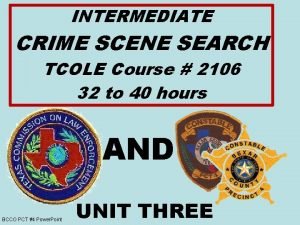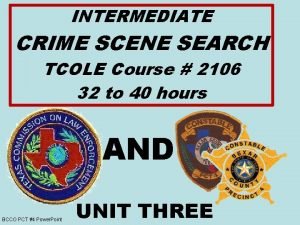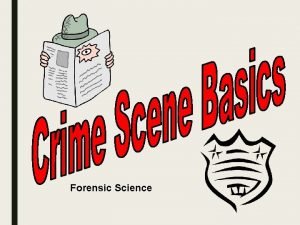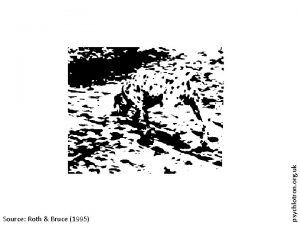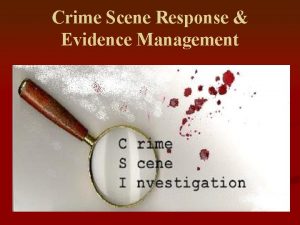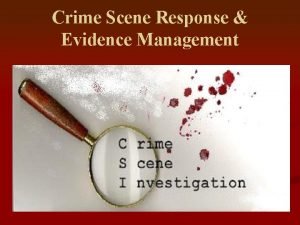psychlotron org uk What does this crime scene













- Slides: 13

psychlotron. org. uk What does this crime scene tell you about the offender responsible?

Two important ideas • Behavioural evidence – Things that tells us how an offender went about committing a crime – The idea that a person’s behaviour at a crime scene is consistent with their behaviour in other contexts psychlotron. org. uk • Criminal consistency

Today’s session You are learning to. . . • Draw inferences from behavioural data • Apply profiling principles to make judgements about offenders • Compare and contrast psychological ideas psychlotron. org. uk You are learning about. . . • Typological offender profiling

Typological offender profiling • Developed by the US Federal Bureau of Investigation (FBI) in the 1970 s and 1980 s. • Key ideas: • Generally used in cases of serial violence against strangers esp. sexual or ‘bizarre’ psychlotron. org. uk – There are different types of offender – Behavioural evidence can tell us which type of offender committed a crime – Knowing an offender’s type allows us to predict other things about him

Data assimilation Data compiled from police reports, post mortems, crime scene photos etc. Crime classification Profilers decide whether the crime scene is organised or disorganised Profile generation Offender’s physical, demographic and behavioural characteristics Crime reconstruction Hypotheses about crime sequence, offender & victim behaviour etc. psychlotron. org. uk FBI profiling process

Organised Disorganised General approach Planned and controlled Unplanned and chaotic Weapons Brought to the scene Improvised Evidence Destroyed or removed Left at scene Victim Attempts to control Little attempt at control Offender Unknown to victim Socially & sexually competent Normal/high intelligence Angry/depressed Possibly known to victim Socially & sexually inept Low intelligence Anxious/psychotic psychlotron. org. uk Types of crime scene

Profile these crime scenes • Use the evidence to construct a profile – Organised or disorganised – Behavioural evidence – Known characteristics of serial offenders – Tell the story of the crime – Describe the person responsible psychlotron. org. uk • Your profile should…

psychlotron. org. uk

psychlotron. org. uk

psychlotron. org. uk

Problems with typological profiling – Assumptions about stable types – Incomplete data – Subjective judgements – Small and unusual sample – Validity of methodology – Narrative & anecdotal evidence psychlotron. org. uk • What problems can you identify with the FBI’s approach to offender profiling?

Compare and contrast… – Purpose – Assumptions – Use of categories/types – Types of crime applicable – Evidence base psychlotron. org. uk • How are geographical and typological offender profiling similar and different?

psychlotron. org. uk • Describe and evaluate one or more approaches to offender profiling.
 West memphis 3 crime photos
West memphis 3 crime photos Seven s of crime scene
Seven s of crime scene Types of crime scene
Types of crime scene Margaret schlosser baby
Margaret schlosser baby Final sketch
Final sketch Triangulation method crime scene sketch
Triangulation method crime scene sketch Compass point method
Compass point method Crime scene factoring and quadratic functions answer key
Crime scene factoring and quadratic functions answer key Rough sketch crime scene
Rough sketch crime scene Mock crime scene scenarios
Mock crime scene scenarios Crime scene investigation 2106 tcole course
Crime scene investigation 2106 tcole course Intermediate crime scene search #2106
Intermediate crime scene search #2106 Crime scene factoring and quadratic functions answer key
Crime scene factoring and quadratic functions answer key Crime scene investigation vocabulary
Crime scene investigation vocabulary

